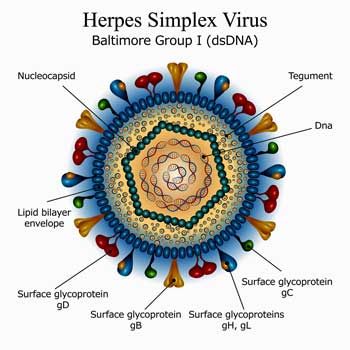

We also hypothesize that migraine may be attributable to a reactivation
of a latent HSV residing within the trigeminal ganglion. The authors
She was a healthy 21-year-old white college student who woke up one morning to a “scintillating scotoma”, a visual aura of writhing dots. That was followed about an hour later by a severe, throbbing headache and nausea; i.e. she had a migraine – her first ever.
The scotoma disappeared in an hour, the headaches lasted for a day, the nausea for three days and the cognitive problems for over a week. Two days later, it happened again and she was diagnosed with an acute migraine.
During the next three months, none of the treatments she tried (NSAIDS, triptans, beta blockers, prednisone and botulinum toxin) helped much. Problems with cognitive functioning forced her to take a semester off from college. Plus she was having trouble with sleep.
She appeared trapped in a classic ME/CFS/FM/migraine/POTS multi-symptom nightmare. Her problems didn’t just include pain – she also experienced significant cognitive issues and sleep problems and her disease was becoming all-encompassing – causing her to drop out of school.
The Pridgen Protocol, Herpes Simplex Virus and Migraine
“On the basis of the current understanding of the pathophysiology of migraine headaches, specifically the role of HSV-mediated trigeminal inflammation in migraine symptomatology and the antiviral characteristics of famciclovir and celecoxib, we believe these medications may work synergistically to treat migraine disorder.” The authors
Seven months later, her doctor tried something different, something very different – an anti-herpes virus protocol. Despite the fact that herpes simplex virus hangs out in the trigeminal nerve and the trigeminal nerve is where migraines originate, almost no work has been done to determine whether HSV is involved in migraine. If you look up antivirals and migraine, there’s almost nothing on it. Migraines are just not treated with antivirals.
But neither is fibromyalgia. Nor have pathogens been looked for. Dr. Skip Pridgen, though, looked at his FM patients and thought that a herpes virus attacking the nerve ganglion might just do the trick. He went on to develop a two-drug (Famvir-Celecoxib) combination to get after the herpes simplex viruses he believes are causing fibromyalgia and similar disorders.

Five days later, the college student reported major improvements in her symptoms including much improved sleep. After two months she was experiencing only mild symptoms and was able to return to full-time college work. She stopped Famvir/Celecoxib after about a year. Fifteen months after starting Famvir/Celecoxib she has only mild symptoms.
This is just a case report – we have no idea if other migraine sufferers would have the same experience. The fact, though, that the regular migraine meds failed, while a drug combo that migraine-treating doctors probably aren’t aware of (and wouldn’t recommend) over time essentially ended this woman’s problems, is something to think about.
Her story demonstrates that drugs out there which no one is currently considering could very well have a significant impact on ME/CFS and FM. The new migraine drugs come to mind. Nobody has assessed the levels of the substance (CGRP) these drugs are blocking in ME/CFS and FM. If somebody actually measures them and finds their levels to be high, a boatload of new drug options could suddenly open up for these diseases.
The Pridgen Connection, Fibromyalgia, Chronic Fatigue Syndrome and Migraine

Pridgen’s FM protocol is being used in other diseases but funding for the phase III FM trials has not materialized yet.
Dr. Pridgen is probably not surprised by this finding. He’s long said that he thinks disorders associated with FM such as ME/CFS and IBS might be able to benefit from his protocol. Logically, that could include migraine, given its high comorbidity, particularly with fibromyalgia, and the close association of the herpes simplex virus with the trigeminal nerve.
Pridgen looked for herpes simplex virus in the guts of FM patients and found it but has said that he believes it’s causing trouble in other places in the body. These viruses are known for the cold and genital sores they can produce, but they probably hang out on in nerve ganglions across the body and could interrupt the signaling between these and many of our organs, glands, skin, blood vessels, and muscles. Van Elzakker has proposed that ME/CFS is caused by viral activity in the nerve cell ganglion found around the vagus nerve. Work is underway now to assess this hypothesis.
Check out more on herpes simplex virus, including the many places it may be able to hide out in the body, in Albert Chang’s Health Rising blog.
If Pridgen is right about FM, it makes sense that his protocol might work for migraine as well. This is as noted, just a case report – something Na Pier felt they wanted to get out in the medical literature in hopes that it will draw more interest. Let’s hope it does.
Pridgen is still looking for funding for his big phase III FM trials. Let’s hope he gets it and we can get a clear sense of how effective his protocol is in FM. If it’s successful, it will open up both a new window on treatments for fibromyalgia and a new understanding of the disease – and perhaps provide a springboard for more trials in other diseases.
- Find out more about Dr. Pridgen’s work in Health Rising’s “The Pridgen Protocol: A Fibromyalgia and Chronic Fatigue Syndrome (ME/CFS) Resource Center“







Never heard about the Pridgen Protocol before but it certainly looks promising and hopefully more research in the fibromyalgia field will continue to be developed.
Find this article very informative. Please continue publishing latest information on fibromyalgia.
Will do. Do check out the blogs 🙂
Cort has published 3 other Pridgen-specific articles – check them all out – really informative.
Plus, you can see that Pridgen himself participated in the Comments Sectons.
Hello Cort thanks for the great news….. I have fibromyalgia since birth I have been in chronic pain……
I have allodynia do you know if Dr. Pridgens protocol helps with Allodynia thanks you so much for the hope…. All the best By the way I am 50 years old….
If it works – yes, if it works I would think it would help with allodynia as well
Has anymore ever tired the NEMECHEK PROTOCOL. It also treats bad bacteria’s etc. Just wondered.
After reading the previous articles on Pridgen, we asked our new family doctor to review them, and he did put our daughter (32) on celebrex and, not famvir, but valtrex instead. But she has not improved after nearly 3 months. She does need the balance of her other FM and ME symptoms treated, in the way Mr. X had Pridgen treat his. We will ask to switch to Famvir or Valcyte next visit. And yet, she and I both have migraines often, though not usually severe.
I am VERY disappointed to read, Cort, that funding has still not come in to start phase III of his trial. 🙁 I was expecting results by the end of this year…
Thanks for this. I’m glad you are able to think, study and write so well for us, and even travel now and then to conferences. Looking forward to part 2 of the Canadian conference. Merci!
Typo, that was “And YES, we have migraines” not “yet”.
It was nice to see your doctor being flexible. Dr. Pridgen is very open to communicating with other doctors about dosing. If your doctors switches to Famvir if he hasn’t reached out to Pridgen about dosing now might be the time, and yes, Pridgen is adamant that other parts of ME/CFS must be treated at the same time.
I am getting a little worried about finding funding for the Phase III trial. He’s been on the hunt for funding for at least a year. Two major attempts to get FDA approval for two FM drugs failed in the last year – both of which seemed likely to succeed. I wonder if drug companies are a little gun shy right now.
Why do you think that might be, Cort? Why might drug companies suddenly be getting gun shy? What might be the cause/trigger for that?
Didn’t Pridgen have something or some-company all on board?
This train seemed really on track in the last article you published on Pridgen – how did the train go so badly off the rails?
There is much more to the protocol than just two drugs. Dosages are also critical and likely your doses are too low. I can answer additional questions at tsasurgery@gmail.com
Hello Doctor do you know of any doctor in the UK willing to try this regimen for me?or are you or anyone willing to do a skype session? thanks
This research compile with the medical medium anthony william. Fibromiyalgia is a really life ruining illness. We are really need help but no working threadment yet
I too was taken aback that Phase 3 Trials for Pridgen have not commenced, especially after reading THROUGH THE VALLEY OF DEATH, and 26 YEARS OF HELL. I thought that trial was well underway:(
I started aciclovir for ME/CFS and had immediate relief from chronic migraine. I still have migraines but they are no longer chronic.
No results in 3+ months?
Are you also doing Dr.Martin Lerner’s supplement protocol to boost ATP and avoiding gluten, dairy, fatty meats, and eggs?
Did you try with same drugs as in the case of pridgen.
Denise I wonder if dosing has anything to do with the success of antiviral and celebrex? good luck to you and your daughter?
This is interesting. I have been on Famvir for several years and every time I have stopped it my migraines have returned within a short time. Prior to Famvir, I had chronic migraines with 20 headache days per month. With the Famvir, I am headache free. Have also been on Celebrex for arthritis so I may have been doing the “protocol” without realizing it.
Glad to see they might actually do some research on this.
The published data found in the Pridgen white paper indicates that use of the antiviral alone, and the celecoxib used alone – that either/or used as a mono-treatment – were ineffective.
Pridgen obviously has in-depth, studied, and nuanced proprietary knowledge about branding and dosage, in addition to the introduction of other drugs.
I wouldn’t let my doctors mess with “experimenting” with Pridgen Protocol-type drugs from just reading published articles without personally consulting Pridgen himself.
Thanks for your comment. I’m glad they are researching this too.
Dear Cort
I am a subscriber from the UK and think I may have found a private clinic willing to prescribe me the Pridgen formula. Can you or anyone else please help me regarding the optimum dose of each one? Many thanks
Just ask Dr. Pridgen – he obviously wants to make himself available to help. His email can be found in his comment above.
If you and your doctor do get help from him, please let us know how it goes!
See Dr. Pridgen’s comment. He is available to talk to your doctor to get the doses and other parts of the protocol correct.
I’m from the U.K. where have you found someone willing to explore this protocol?
hi christine are you able to let me know the name of this clinic please im from the uk and desperate for help
Christine I’m also in the UK and would be very interested to know of a clinic in the UK that would be willing to prescribe and follow Dr. Pridgen’s protocol. Could you please share your info?
I’m in the uk too, did you find a dr that linked with dr Pridgen to do his protocol? I’d love to try it too
Please could I find out the dr in uk ? Please
After reading several of your articles, I do believe that HSV is the cause of many of my health problems. I’m dealing with FM.CFS.MIGRAINES and other issues. The articles are very enlightening, and I’ll keep reading
I am curious if this could potentially help for people who have CFS/ME that wasn’t triggered by a virus.
So those of us who have Bacterial triggered, or Auto-Immune triggered ME.
Dear Cort & Fellow Fibromyalgia & CFS suffering souls;
I urge each of you to go to parathyroid.com & read about how hyperparathyroidism(caused by parathyroid tumor(s) signs & symptoms MIRROR many of the FMS/CFS signs & symptoms. I have discovered that I have at least one tumor & am scheduled to have it removed on June 12, 2018 at the Norman Parathyroid Center in Tampa, Fl. These are the “go to” docs for parathyroid tumors….don’t trust anyone else for this delicate surgery. Once you peruse the website, you will see why I am saying that.
Looking forward to kicking FMS to the curb & praying for ALL who read this will do the same!!!!!!!!!
May God Guide, Heal, & Restore You
Karen Limbaugh, RN
Thanks Karen
Good luck with the surgery. Here’s some more information on that from Health Rising
https://www.healthrising.org/blog/2014/05/08/alternate-diagnoses-fibromyalgia-hyperparathyroidism-treatable-condition/
I traveled from Ohio to Alabama and met with Dr Pridgen and subsequently started on the Pridgen protocol for Fibromyalgia. I did wonderful for the first 9 months or so and then developed stomach ulcers from the Celebrex, which I’m still suffering from. I had to stop the protocol due to the stomach ulcers. I have since started on Low dose Naltrexone for my Fibromyalgia symptoms and have been on this for about 4 years now and doing good. I have nothing against Dr Pridgens protocol, it just wasn’t for me. He is a great Dr who truly cares for his patients and was very responsive to even my texts while I was on his med combo. Best of luck to all who fight this terrible debilitating disease.
Thanks for sharing Robin 🙂
Robin
I’m sorry to hear about your stomach ulcers . I’ve been taking Celebrex trying to taproot my neck pain a great deal. And I am running into a pretty big stomach upset with it. Did you try omeprozale to see if I could have put a talk with the Celebrex? I’m just curious what options are because I’d like to continue taking the Celebrex but I’ve heard there can be side effects from that omeprozale
I’ve heard Repairvite can work well for acid reflux.
This is a brilliant and simple concept, viral reactivation as a cause for migraines. Thank you, I will spread the word locally in the medical community!
I have had ME/CFS for the past 46 years. Nothing much has changed, maybe a bit better, the same old migraines, PEM, extreme fatigue arising in the early afternoon, abating somewhat in the evening, and wicked pressure headaches. I was diagnosed by Dr. Bell in the early 90s. He tried me on doxycycline for a few months – no soap.
If Dr. Pridgen is willing, I could contact my physician at MUSC in Charleston, Dr. Player, with his recommended dosages if his office will divulge them, or have Dr. Player’s office call his office. Thanks.
Dr. Pridgen seems very willing to collaborate with other physicians. Good luck!
I developed chronic migraines within a few days of taking the Shingles vaccine. At first, it was a couple a week then it progressed to everyday, occurring most often between 2 AM and 4 AM. This was 5 years ago and I’ve tried all the usual migraine treatments but none have worked. A grain-free, low carb diet works better than anything and without all the side effects. This article makes perfect sense about antivirals helping migraines. My pain is right where the trigeminal nerve forks on the right forehead. I’ve read that glucose feeds viruses and that’s why a low carb diet helps and lysine also helps keep it in check. The Pridgens protocol just might be what ties up all the loose ends. I hope this is explored further for migraines.
Do we have any updates on the phase III trials? I would like to participate. I didn’t really give this protocol much weight since I have never had a cold sore or any herpes outbreak. My bloodwork does show EBV. However, when I read in the article that the herpes virus can live in the trigeminal nerve, I perked up. This is actually one of my most severe symptoms; the facial nerve is constantly inflamed and burning. It flares badly if I get a whiff of perfume fragrance. I assumed the chemical sensitivity was part of the FM syndrome like other sensitivities can be. Now I’m taking a second look at Dr. Pridgen.
Can you use Valtrex instead of Famvir??
So interesting! Just stumbling onto this now. My daughter was tested for HSV by her neurologist (who specializes in migraine) in his initial evaluation several years ago. Blood tests were negative, so I’m assuming this is not a good option for her, but it is always great to read about research being done. Thanks for your blogs, Cort.
Hv FM and for years and frequent blisters on my lips , forehead, shoulder and chin and using Famvir everytime I was experiencing a good period of feeling healthy and no migraines and no dry skin and no sinus problems and was always thinking the Famvir is helping with my FM symptoms. I was excited to read this blog.